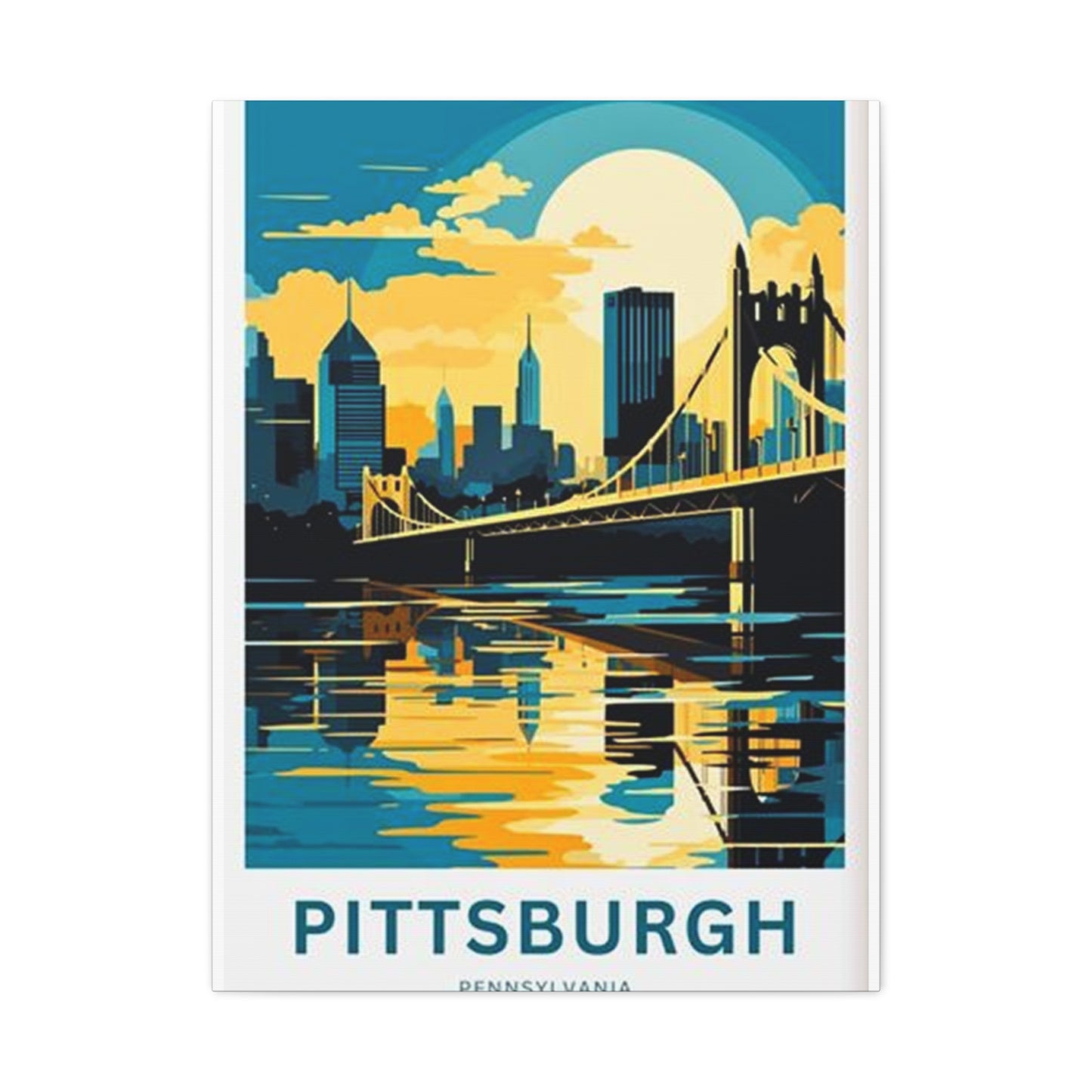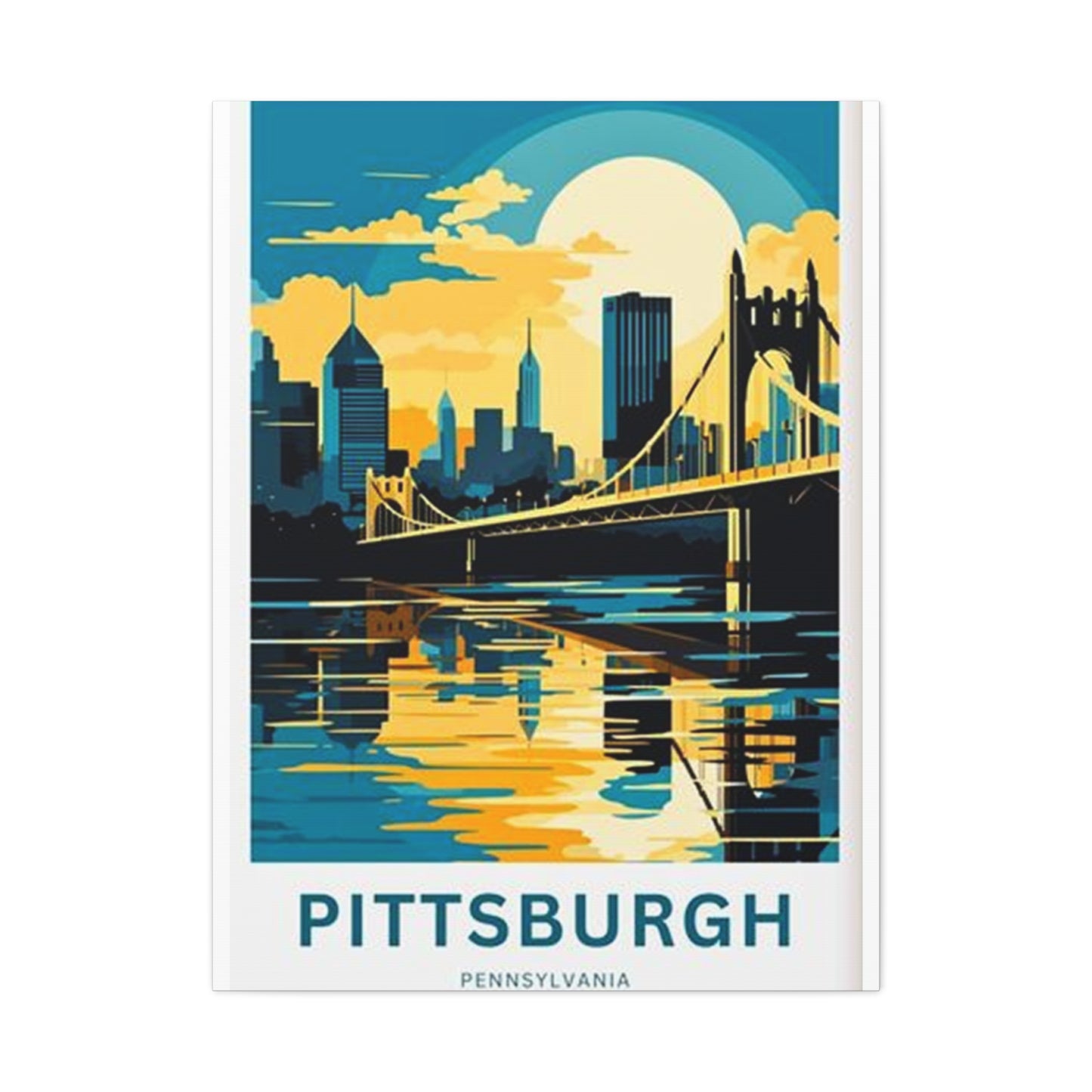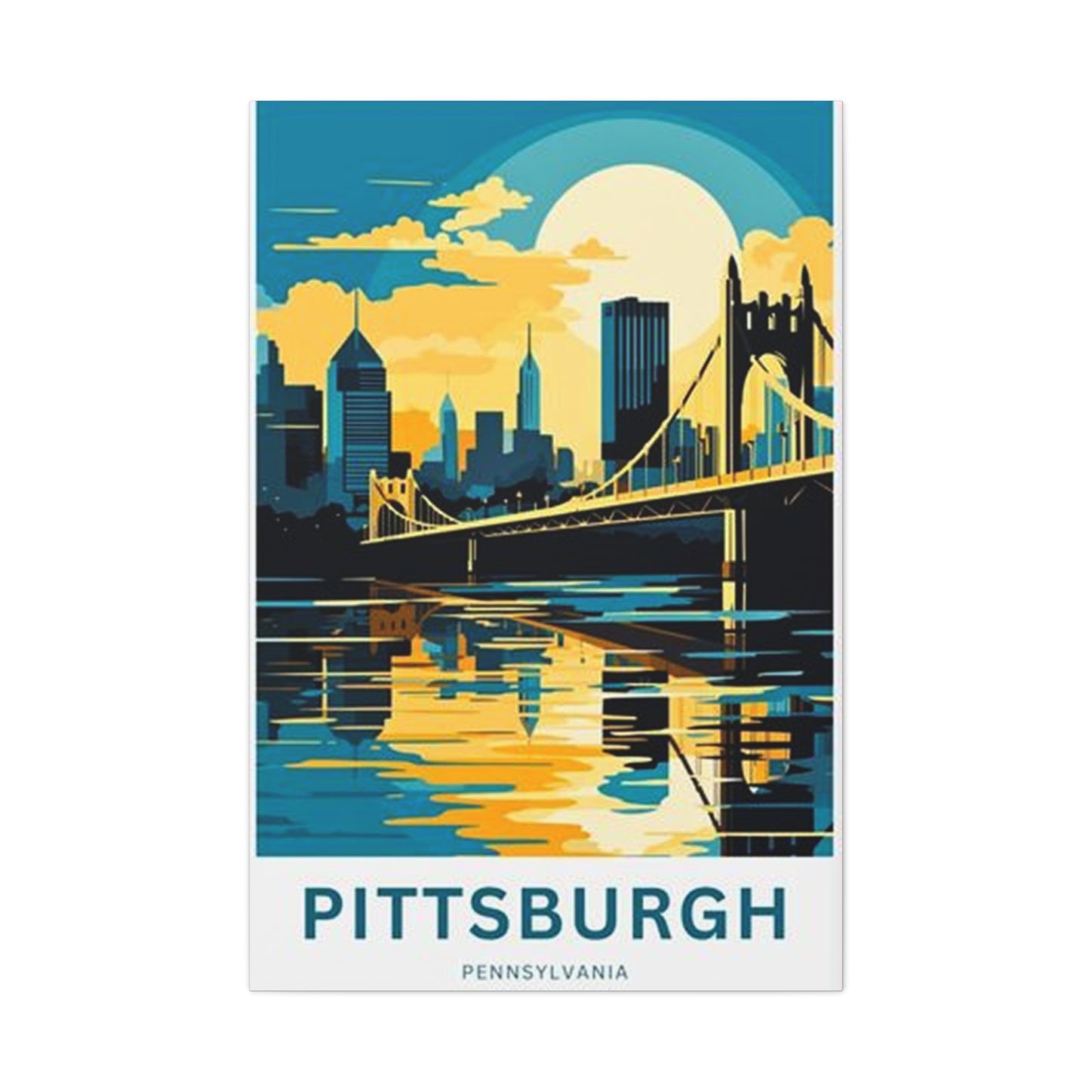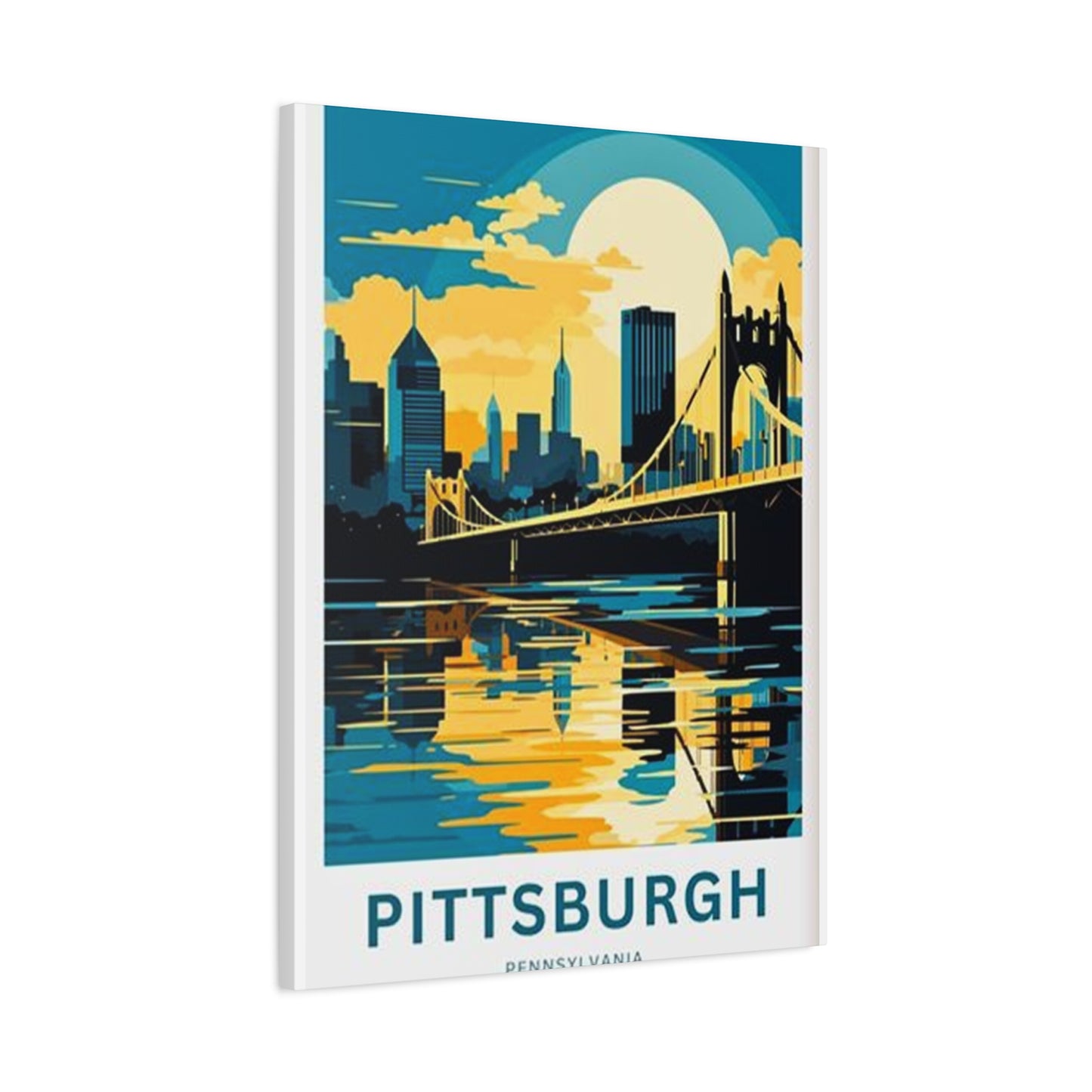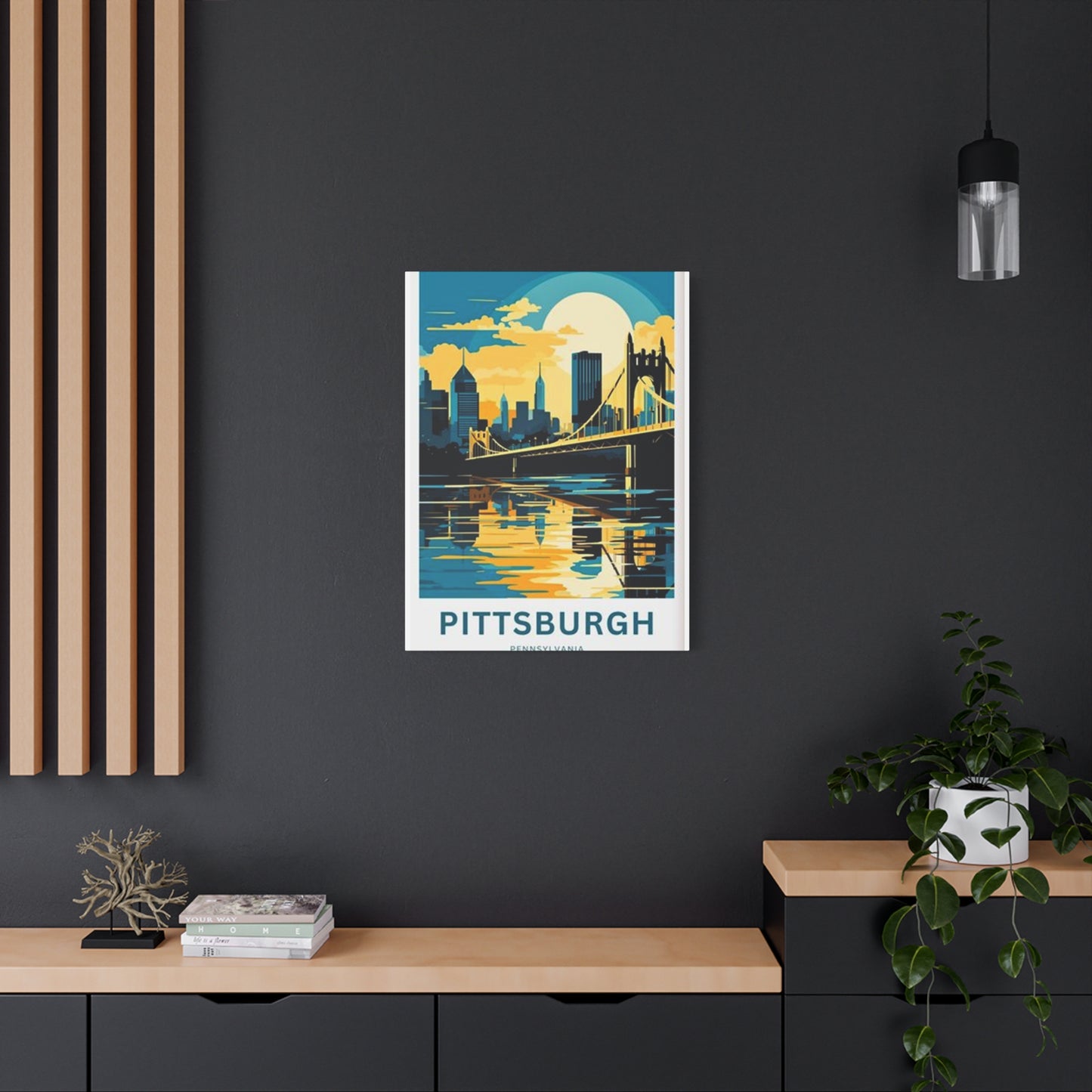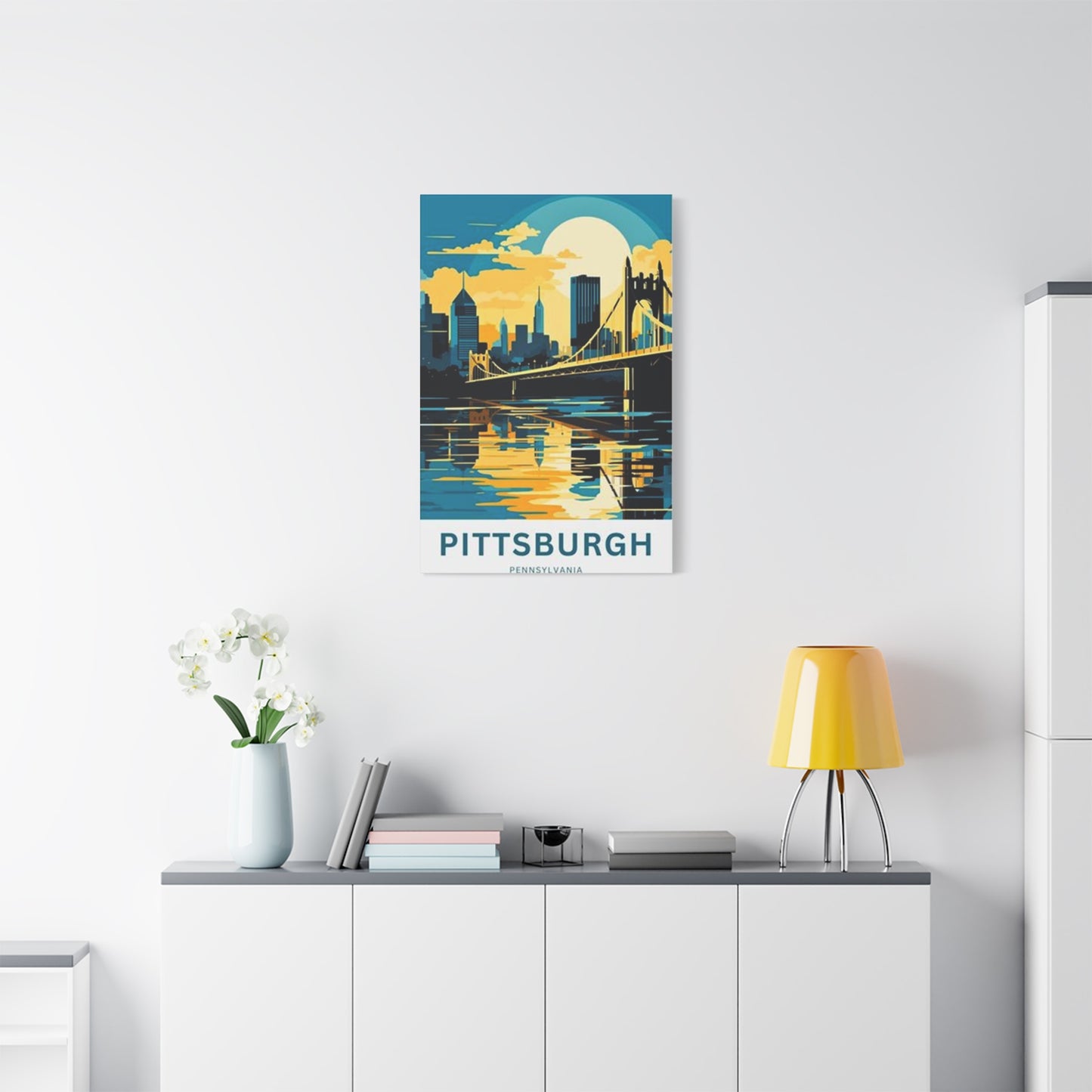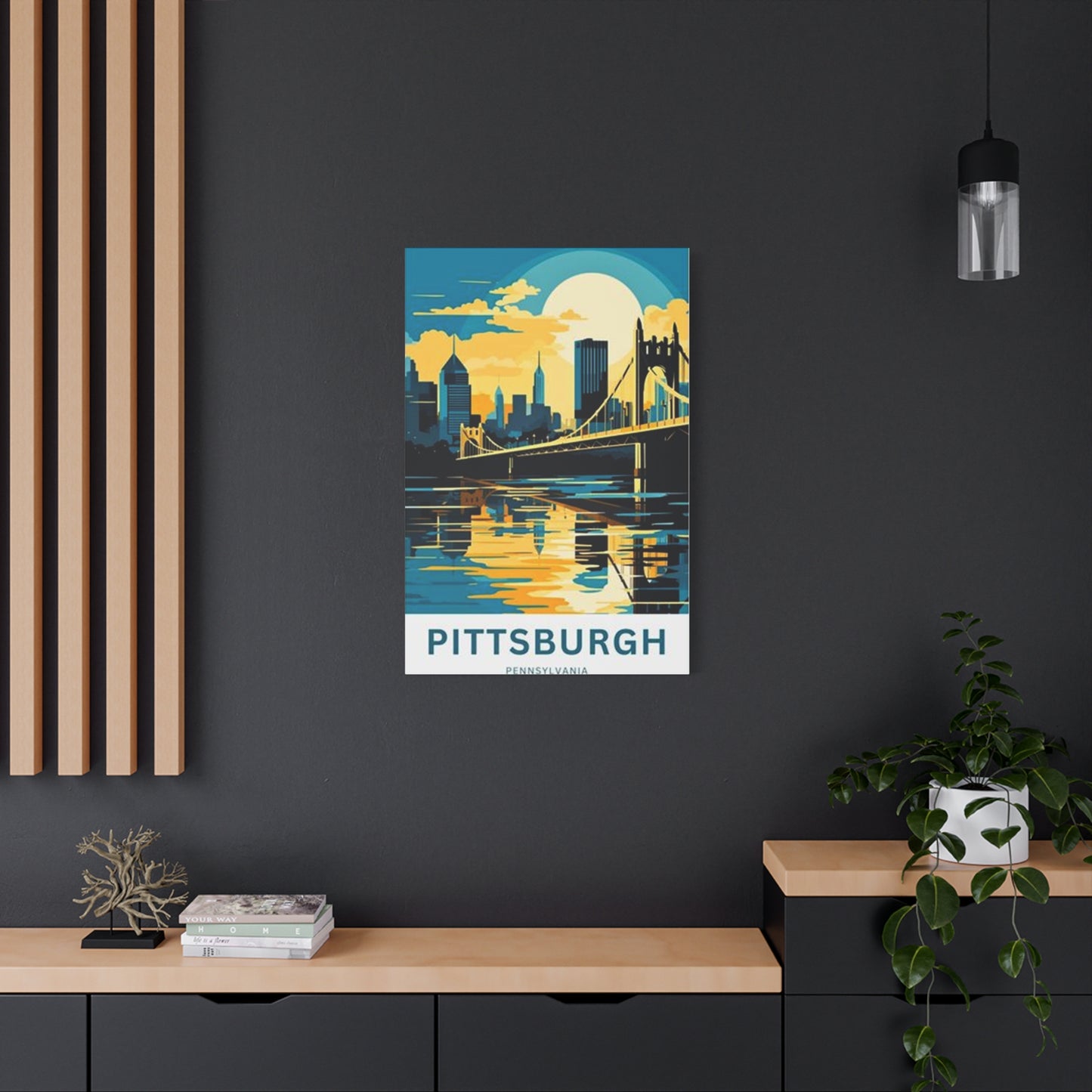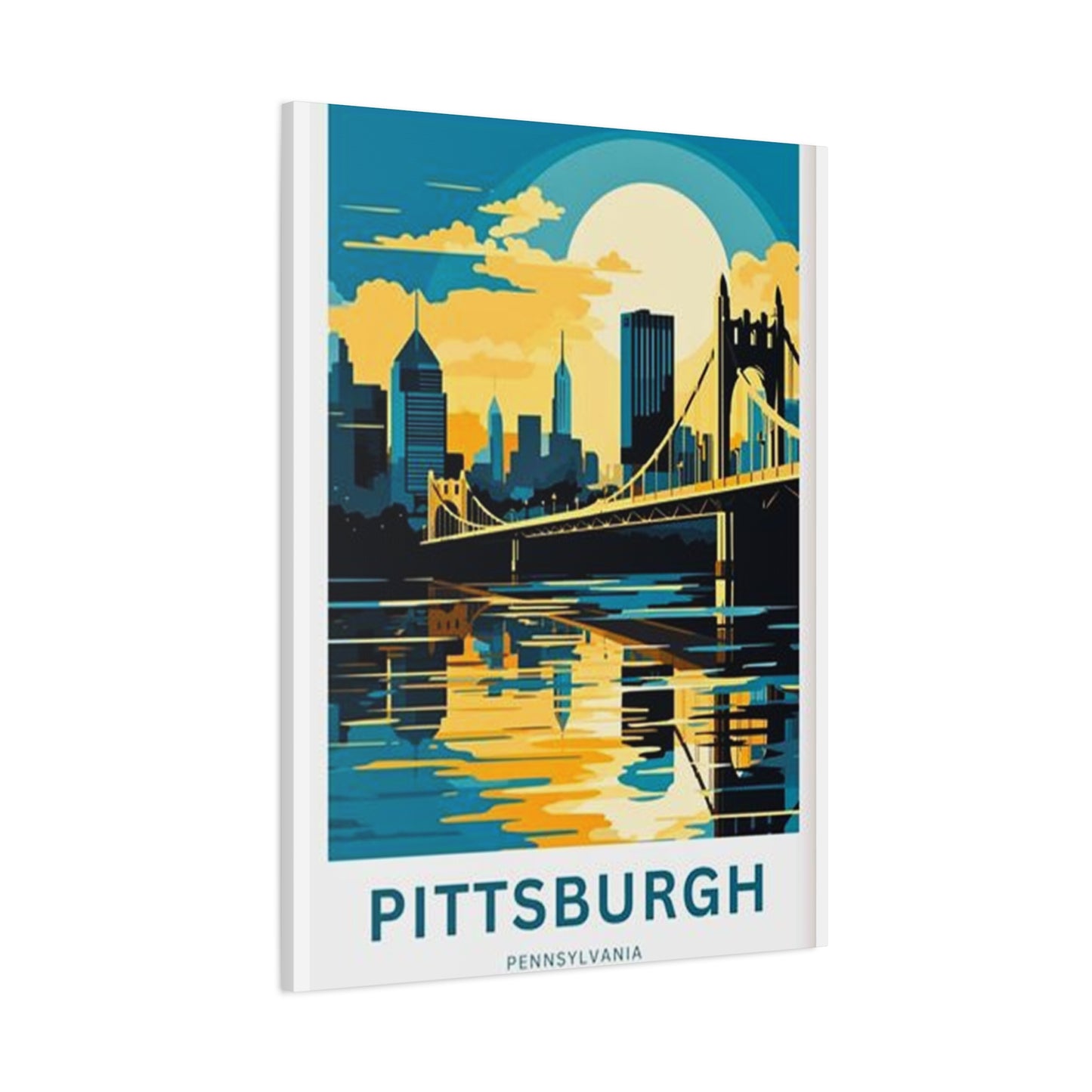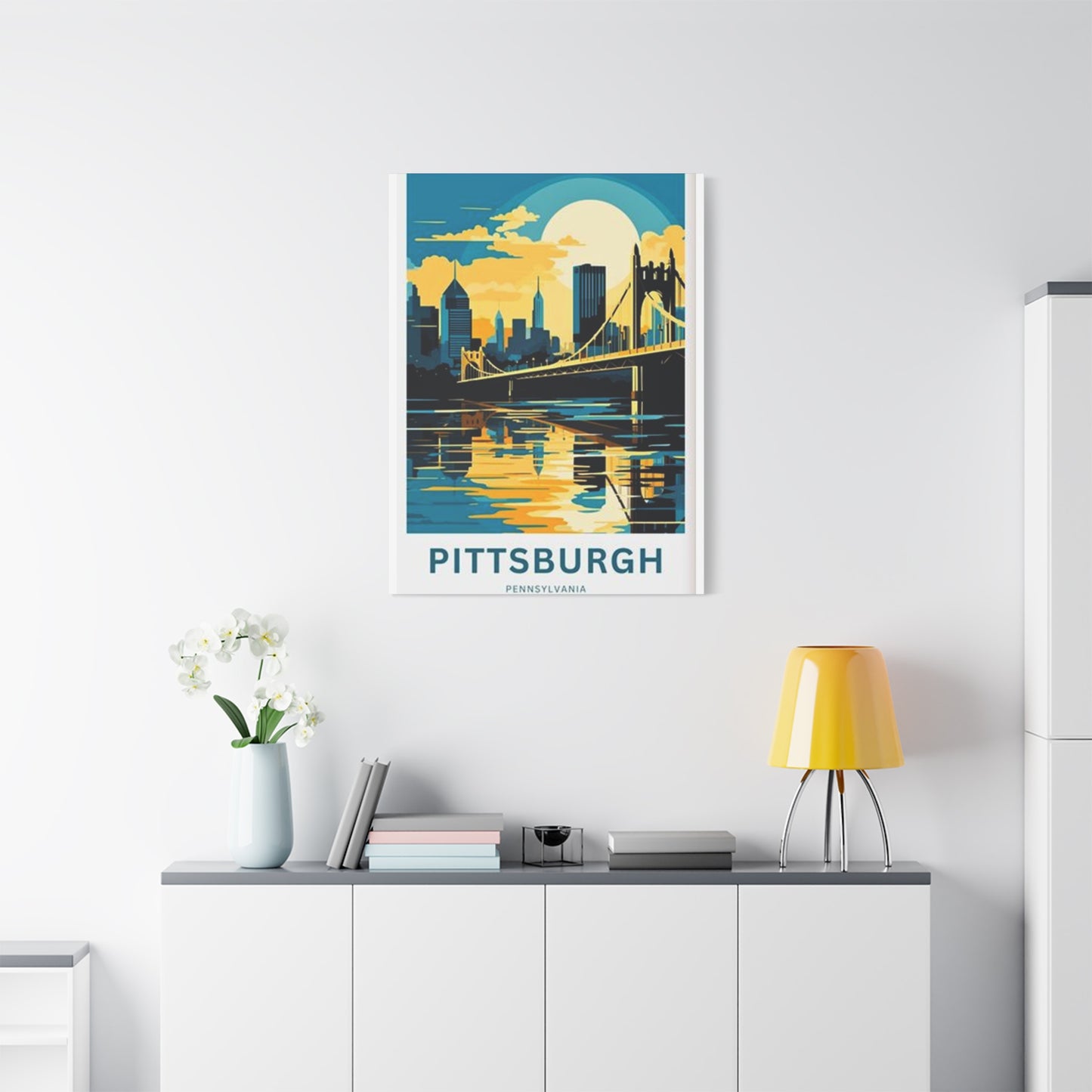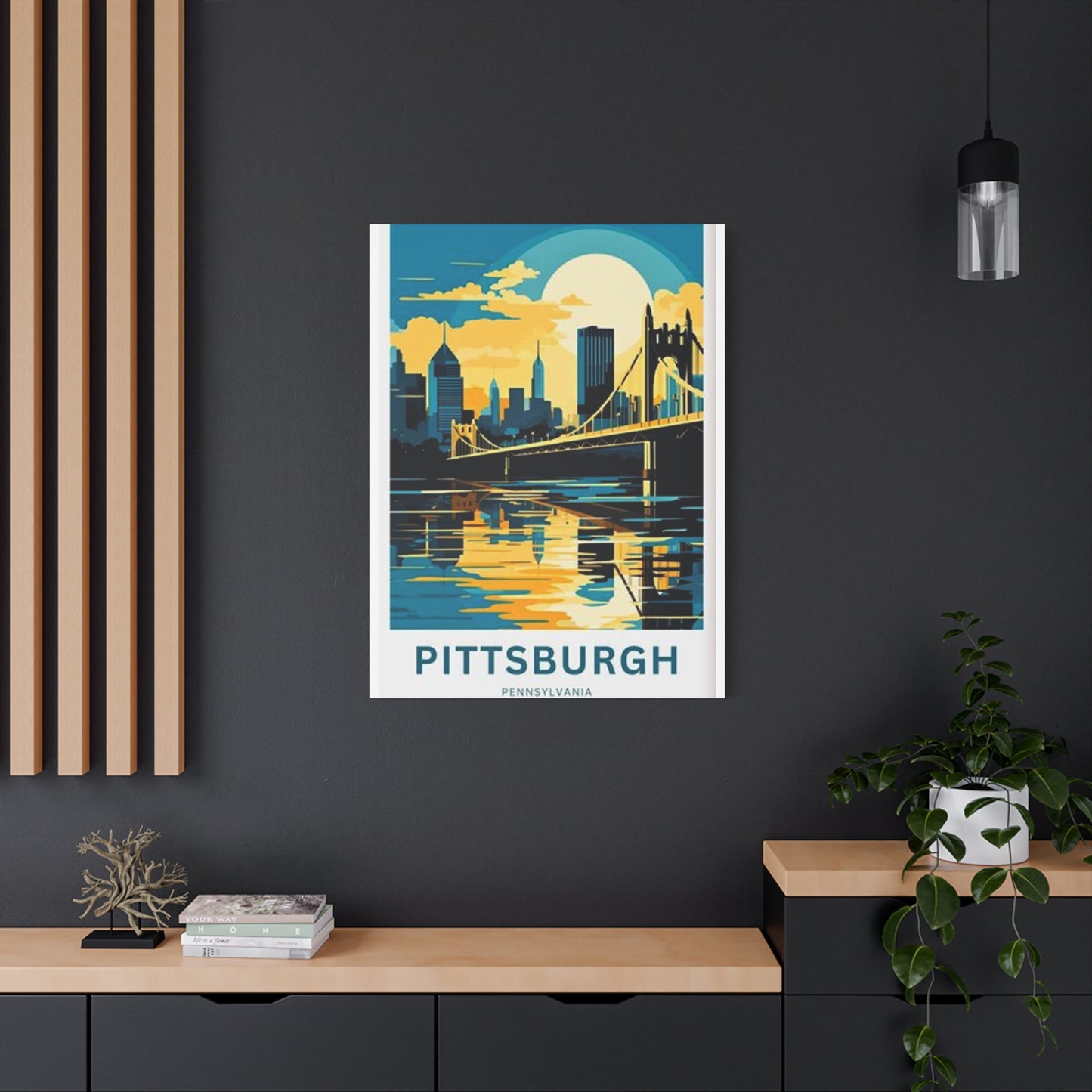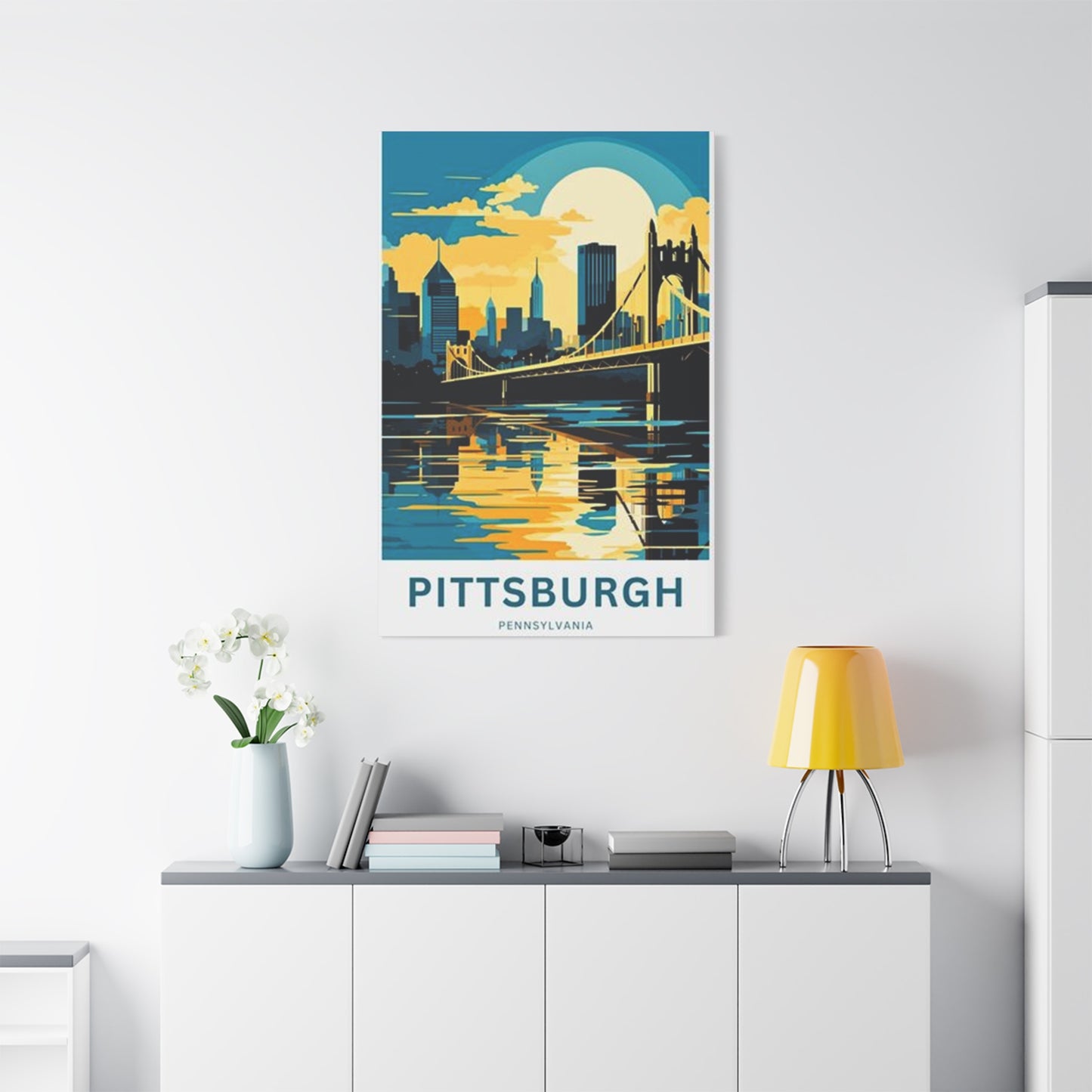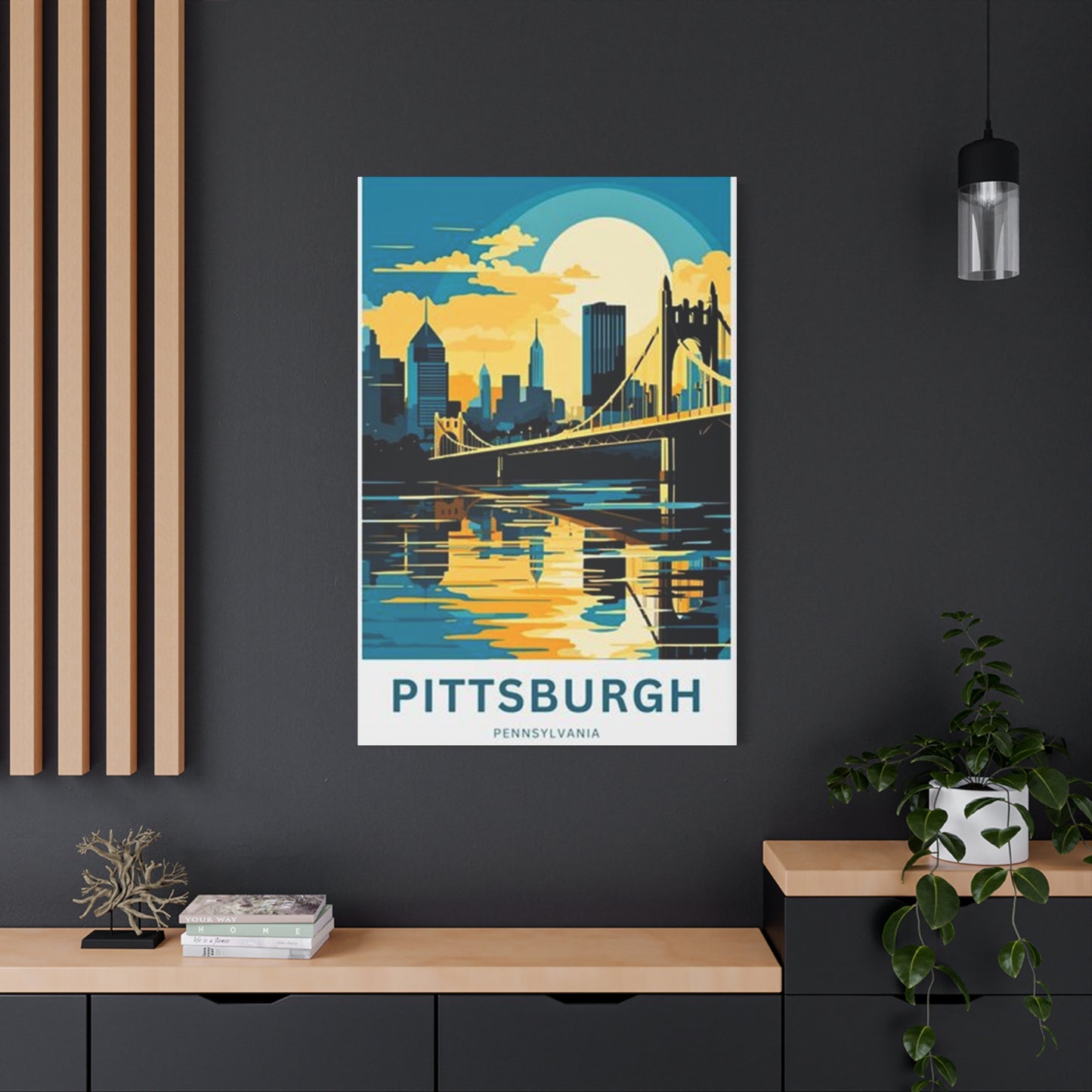Screen Printing Steel City: Behind the Scenes of Handmade Pittsburgh Poster Wall Art
The allure of Pittsburgh extends far beyond its bridges and skyline. This remarkable city, known affectionately as the Steel City, has captured the hearts of residents and visitors alike with its unique blend of industrial heritage, stunning architecture, and vibrant cultural scene. Pittsburgh poster wall art canvas prints offer an exceptional way to bring the essence of this magnificent city into your home or office, creating visual narratives that celebrate everything from the iconic Three Rivers to the golden bridges that define the cityscape. These artistic representations serve not merely as decorative elements but as powerful statements of connection, pride, and appreciation for one of America's most resilient and beautiful urban landscapes.
The Enduring Appeal of Pittsburgh in Wall Art
Pittsburgh holds a special place in American urban culture, representing transformation, resilience, and architectural beauty. The city's journey from industrial powerhouse to modern metropolitan center creates a compelling visual story that translates beautifully into wall art. Canvas prints capturing Pittsburgh scenes resonate deeply with those who have lived in or visited the city, evoking memories of walking along the riverfront, crossing the distinctive yellow bridges, or watching the sunset paint the skyline in golden hues. The emotional connection people feel toward Pittsburgh makes these art pieces more than simple decorations; they become conversation starters, memory keepers, and symbols of belonging.
Whether you're a lifelong resident, a college alumnus, or someone who simply fell in love with the city during a visit, Pittsburgh wall art allows you to maintain that connection regardless of where life takes you. The variety of artistic styles available means there's something for every aesthetic preference, from photographic realism that captures every architectural detail to abstract interpretations that convey the city's energy through color and form. These pieces work equally well in residential settings, from cozy apartments to spacious homes, and in professional environments where they can represent local pride and community connection.
Understanding Canvas Print Quality and Materials
The foundation of exceptional Pittsburgh wall art lies in understanding the materials and processes that create lasting, vibrant pieces. Canvas prints represent a significant evolution from traditional poster paper, offering texture, depth, and durability that paper simply cannot match. High-quality canvas typically consists of cotton or polyester blends, with cotton canvas providing superior texture and a more traditional art feel, while polyester options offer enhanced durability and resistance to environmental factors. The weight of the canvas, measured in grams per square meter, directly impacts the final product's quality, with heavier canvases generally providing better print retention and longevity. Premium canvas prints utilize materials ranging from 300 to 450 GSM, ensuring the fabric can support detailed images without sagging or losing shape over time.
The weave pattern of the canvas also matters significantly, with tighter weaves providing smoother surfaces for detailed photographic prints, while more textured weaves can enhance artistic interpretations and paintings. Understanding these material considerations helps you select Pittsburgh wall art that will maintain its beauty for years, resisting fading, moisture damage, and the natural wear that comes with time. The canvas preparation process includes priming, which creates a receptive surface for inks and protects the underlying fabric from deterioration. Quality primers ensure color accuracy, prevent ink absorption that could dull images, and create barrier protection against environmental factors like humidity and temperature fluctuations.
Printing Technologies That Bring Pittsburgh to Life
The technology behind canvas printing has advanced dramatically, enabling reproduction of Pittsburgh scenes with unprecedented accuracy and vibrancy. Giclée printing represents the gold standard in canvas reproduction, utilizing specialized inkjet printers that spray microscopic droplets of pigment-based inks onto canvas surfaces. This process creates smooth color transitions, extraordinary detail retention, and color accuracy that rivals original photographs and paintings. The term giclée, derived from French meaning to spray or squirt, has become synonymous with museum-quality prints that collectors and art enthusiasts trust for long-term value. These printers employ multiple ink cartridges, sometimes twelve or more individual colors, allowing for color range and subtlety impossible with standard four-color printing processes.
For Pittsburgh skyline prints, this means capturing the precise gradations of sunset colors reflecting off glass buildings, the subtle variations in bridge paint colors, and the atmospheric perspective that gives depth to river valley scenes. UV-resistant pigment inks ensure these prints maintain their vibrancy for decades, with properly displayed pieces showing minimal fading even after fifty years or more. The resolution capabilities of modern canvas printing allow for enormous prints without quality loss, meaning you can display a panoramic Pittsburgh skyline spanning an entire wall while maintaining crisp detail in every window and architectural element. Advanced color management systems ensure prints accurately represent the original photographs or artwork, with calibrated monitors and printers working in harmony to reproduce exactly what the artist or photographer intended.
Iconic Pittsburgh Scenes Perfect for Canvas Prints
Pittsburgh offers an extraordinary variety of visually striking scenes that translate beautifully into wall art. The city skyline, viewed from Mount Washington or the North Shore, provides perhaps the most recognizable and beloved image, with its distinctive collection of skyscrapers creating a compact yet impressive urban profile. The confluence of the Allegheny, Monongahela, and Ohio Rivers creates unique vantage points where water, bridges, and buildings interact in compositions photographers and artists find endlessly fascinating. The Roberto Clemente Bridge, Andy Warhol Bridge, and Rachel Carson Bridge, painted in distinctive Aztec gold, create powerful visual elements that anchor Pittsburgh imagery with immediate recognition. These suspension bridges, particularly when lit at night, offer dramatic subjects that capture both the city's industrial heritage and its modern vitality.
The historic neighborhoods like the Strip District, with its vibrant market atmosphere and colorful storefronts, provide street-level perspectives that showcase Pittsburgh's diverse character beyond the famous skyline. Lawrenceville's artistic murals and eclectic architecture offer contemporary urban scenes that appeal to those seeking modern, edgy Pittsburgh representations. The Cathedral of Learning, standing majestically in Oakland, represents educational excellence and Gothic Revival architecture that creates striking vertical compositions. Heinz Field and PNC Park, homes to Pittsburgh's beloved sports teams, capture the city's passionate sports culture in images that resonate with Steelers and Pirates fans worldwide. Historic inclines, particularly the Duquesne and Monongahela Inclines, provide both transportation history and stunning elevated viewpoints that make for unique wall art subjects.
Seasonal Pittsburgh Imagery Capturing Changing Beauty
Pittsburgh's distinct seasons each offer unique visual characteristics that make seasonal canvas prints appealing for those wanting to capture specific times of year or create rotating displays. Spring brings renewal to the city, with trees along riverbanks and in urban parks displaying fresh green foliage that contrasts beautifully with steel and concrete infrastructure. Cherry blossoms and flowering trees in places like Mellon Park and Schenley Park create brief but spectacular displays that photographers eagerly capture. The softer, diffused light of spring creates gentle, optimistic imagery perfect for spaces where peaceful, uplifting atmospheres are desired. Summer Pittsburgh bursts with full foliage, with mature trees creating lush green backdrops that soften the urban landscape. Long daylight hours provide opportunities for both extended golden hour photography and dramatic twilight scenes where city lights begin glowing against still-bright skies.
Summer also brings outdoor activities along the rivers and in parks, adding human elements and recreational contexts to Pittsburgh imagery. Fall transforms Pittsburgh into a spectacular display of autumn colors, with hillsides surrounding the city painted in reds, oranges, and yellows that create some of the year's most stunning vistas. The combination of colorful foliage with golden bridges and the steel-gray river creates compositions rich in warm tones that bring coziness and energy to interior spaces. Fall light, with its lower angle and golden quality, enhances these colors while creating longer shadows that add depth and dimension to photographs. Winter reveals Pittsburgh's architectural bones, with leafless trees no longer obscuring buildings and bridges, creating stark, graphic compositions that emphasize structure and form. Snow-covered scenes transform familiar Pittsburgh landscapes into wonderlands of white and gray punctuated by the warm glow of streetlights and building windows.
Abstract and Artistic Interpretations of Pittsburgh
Beyond photographic representations, abstract and artistic interpretations of Pittsburgh offer alternative approaches that prioritize emotion, color, and creative vision over literal accuracy. Impressionistic paintings of Pittsburgh scenes capture the essence and feeling of locations through loose brushwork and vibrant color choices that convey energy and movement rather than precise detail. These interpretations work beautifully in creative spaces, bringing artistic flair that purely photographic prints cannot match. Watercolor renditions of Pittsburgh landmarks offer delicate, luminous qualities with colors that seem to glow from within the paper or canvas. The medium's characteristic soft edges and color bleeds create dreamy, romantic versions of familiar scenes that add gentleness to interiors. Pop art treatments transform Pittsburgh imagery through bold colors, high contrast, and graphic simplification reminiscent of Warhol, appropriately given his Pittsburgh roots.
These vibrant, eye-catching pieces suit contemporary spaces and younger demographics who appreciate art that makes bold statements. Minimalist line drawings reducing Pittsburgh skylines or bridges to essential outlines create sophisticated, modern pieces that work in professional settings or homes with contemporary design aesthetics. These simplified representations focus on recognizable silhouettes while removing distracting details, creating calm, ordered images that don't overwhelm spaces or compete with other design elements. Geometric abstractions break Pittsburgh scenes into shapes, patterns, and color blocks, creating pieces that reference the city while functioning primarily as abstract art. These works appeal to those wanting subtle Pittsburgh connections without obviously representational imagery. Mixed media collages incorporating photographs, textures, text, and graphic elements create layered, complex Pittsburgh representations that reward close viewing and repeated examination.
Sports-Themed Pittsburgh Wall Art for Fans
Pittsburgh's passionate sports culture creates enormous demand for wall art celebrating the Steelers, Pirates, and Penguins. Stadium imagery capturing Heinz Field, PNC Park, and PPG Paints Arena from dramatic angles provides instantly recognizable subjects that resonate with sports enthusiasts. Aerial perspectives showing these venues in their urban contexts emphasize their roles as architectural landmarks beyond their function as sporting facilities. Action photography from memorable games, when properly licensed, creates powerful statements for serious fans, though licensing restrictions and costs make officially licensed sports photography expensive compared to general Pittsburgh cityscape prints. Alternative approaches include vintage sports imagery, using historical photographs or reproduction vintage posters from earlier eras of Pittsburgh sports.
These pieces combine team loyalty with nostalgic aesthetics that appeal across generations. Typography-based sports art, featuring team names, championship years, or famous player names in creative layouts, offers modern, graphic approaches to sports-themed decoration. These pieces work particularly well in recreational spaces, home theaters, or casual areas where sports viewing occurs. Color-focused abstract pieces using team colors without obvious imagery allow for sophisticated sports allegiance expression in more formal settings where obviously themed sports decoration might seem inappropriate. Deep blacks and golds for Steelers fans, black and gold for Pirates supporters, and black, gold, and white for Penguins enthusiasts create color schemes that reference teams while maintaining design sophistication. Neighborhood maps highlighting areas around stadiums appeal to those who attended games regularly or have fond memories of particular locations near sporting venues.
Installation Methods for Canvas Prints
Properly installing Pittsburgh canvas prints ensures they display beautifully while remaining secure on walls. Gallery-wrapped canvases typically come with hanging hardware pre-installed, most commonly sawtooth hangers attached to the back of stretcher bars. These simple metal hangers work adequately for lightweight prints but may not provide sufficient support for larger, heavier pieces. For substantial canvases, wire hanging systems offer better weight distribution and hanging flexibility. Wire stretched between two D-rings or screw eyes allows for minor adjustments to level pieces without removing them from walls. The wire should be strung with slight slack rather than taut, creating a V-shape when the piece hangs that distributes weight to both attachment points.
Heavy-duty wall anchors become necessary when hanging large Pittsburgh prints on drywall, as standard picture nails rarely provide adequate support for pieces exceeding ten pounds. Toggle bolts, molly bolts, or expanding plastic anchors grip wall material much more securely, preventing accidents from prints pulling free and falling. Locating wall studs using electronic stud finders allows for the strongest possible mounting, with screws driven directly into wooden framing members capable of supporting substantial weight without additional anchoring hardware. For truly massive Pittsburgh panoramas or gallery wall arrangements, French cleat systems provide professional-grade support with the added benefit of allowing easy removal and repositioning. These systems use interlocking beveled strips, with one attached to the wall and its mate attached to the artwork, creating secure, weight-distributed hanging that resists accidental dislodging.
Lighting Considerations for Artwork Display
Proper lighting dramatically impacts how Pittsburgh canvas prints appear, revealing details, enhancing colors, and creating ambiance that elevates artwork from mere decoration to room-defining features. Natural light provides the most accurate color rendering and creates dynamic displays that change throughout the day as sun angles shift. However, direct sunlight poses serious risks to canvas prints, with ultraviolet radiation causing color fading and material degradation over time. Windows allowing direct sun exposure should be covered with UV-filtering films or curtains during peak sun hours to protect valuable artwork while still allowing natural light into spaces. Artificial lighting offers more control over how Pittsburgh prints appear, with several approaches providing excellent results. Picture lights, those small fixtures mounted directly above artwork, create focused illumination that highlights pieces while adding ambient glow to surrounding areas.
LED picture lights offer advantages over traditional incandescent or halogen options, producing minimal heat that won't damage canvases while using far less electricity. Track lighting systems provide flexible solutions for illuminating multiple Pittsburgh prints or gallery wall arrangements, with adjustable fixtures allowing precise aiming that accounts for different piece sizes and positions. The color temperature of bulbs significantly affects how artwork appears, with warm white light around 2700 to 3000 Kelvin creating cozy, inviting atmospheres that enhance warm colors in Pittsburgh sunset scenes. Cool white light at 4000 to 5000 Kelvin provides crisp, clean illumination that works well with contemporary spaces and black and white Pittsburgh photography. Recessed ceiling lights can effectively illuminate wall art when properly positioned, though care must be taken to avoid mounting them too close to walls, which creates harsh grazing light that emphasizes wall imperfections rather than artwork.
Creating Gallery Wall Arrangements with Pittsburgh Prints
Gallery walls allow for creative display of multiple Pittsburgh images, telling more comprehensive visual stories than single pieces can achieve alone. Planning gallery arrangements requires careful consideration of how individual pieces relate to each other and to the wall space they'll occupy. Beginning with the largest or most visually important piece as an anchor point provides a foundation around which smaller prints can be arranged. This central piece typically hangs at eye level, traditionally defined as 57 to 60 inches from floor to center point, matching average human eye height and standard museum hanging practices. Symmetrical gallery walls create ordered, formal appearances through balanced arrangements where pieces are arranged in grids or mirror-image patterns. These formal layouts suit traditional interiors and personalities that prefer order and predictability. Asymmetrical arrangements offer more visual interest and creative flexibility, allowing pieces of different sizes to combine in balanced but non-matching compositions.
These organic layouts feel more casual and contemporary, working beautifully in modern or eclectic spaces. Creating paper templates matching the exact dimensions of each Pittsburgh print allows for testing arrangements before committing to nail holes. These templates can be taped to walls and moved repeatedly until the perfect arrangement emerges, with final positions marked before templates are removed and actual hanging begins. Maintaining consistent spacing between pieces creates visual cohesion in gallery walls, with most designers recommending two to four inches between frames as a general guideline. Color coordination across multiple Pittsburgh prints helps unify gallery walls, whether through consistent color palettes, matching mats and frames, or thematic connections that create visual harmony. Subject matter relationships also strengthen gallery walls, perhaps combining Pittsburgh skyline views from different vantage points, seasonal variations of the same location, or a chronological progression showing urban development.
Caring for Canvas Prints to Ensure Longevity
Proper maintenance extends the life and preserves the beauty of Pittsburgh canvas prints for generations. Canvas, while more durable than paper, still requires appropriate care to maintain its appearance over decades of display. Dust accumulation represents the most common maintenance issue, with particles settling on canvas surfaces and dulling colors over time. Regular dusting using soft, clean cloths removes surface dust without abrading or damaging canvas fibers or printed images. Microfiber cloths work particularly well for this purpose, their fine fibers capturing dust particles effectively without scratching. Feather dusters should be avoided despite their traditional association with artwork cleaning, as their stiff quills can catch on canvas textures and potentially damage surfaces. For more thorough cleaning, slightly dampened cloths can remove dust that dry dusting misses, though excess moisture must be avoided as it can cause canvas sagging or damage underlying stretcher bars.
Any moisture used should be minimal, with cloths wrung nearly dry before touching canvas surfaces. Harsh chemicals, cleaning solutions, and abrasive materials must never be used on canvas prints, as these can remove inks, damage protective coatings, or alter canvas fibers. Environmental control significantly impacts canvas print longevity, with stable temperature and humidity levels preventing material expansion, contraction, and degradation. Extreme humidity encourages mold growth on canvas and wooden stretcher bars, while excessive dryness can make canvas brittle and prone to cracking. Ideal conditions maintain relative humidity between 40 and 60 percent with temperatures between 65 and 75 degrees Fahrenheit. Dehumidifiers and humidifiers help maintain these ranges in climates with extreme conditions. Smoke exposure from cooking, fireplaces, or tobacco discolors canvas over time, depositing particles and chemicals that yellow whites and dull colors. Adequate ventilation and air filtration minimize these effects in homes where smoke exposure cannot be entirely eliminated.
Pittsburgh Canvas Prints in Different Interior Design Styles
Pittsburgh wall art adapts beautifully to virtually any interior design aesthetic through appropriate selection of imagery style, color palette, and presentation methods. Contemporary or modern spaces benefit from Pittsburgh prints with clean lines, minimal color palettes, and strong graphic qualities. Black and white skyline photographs, minimalist bridge illustrations, or high-contrast architectural studies complement the simplicity and sophistication that define contemporary design. Gallery wrapping without additional framing maintains the clean, unadorned aesthetic that contemporary spaces demand. Traditional interiors welcome Pittsburgh imagery when presented appropriately, with classic framing styles and conventional subject matter creating harmony with formal furniture and classic architectural details. Sepia-toned historical photographs in ornate gold or dark wood frames honor traditional design principles while celebrating Pittsburgh's heritage. Landscape-oriented Pittsburgh prints showing rivers, parks, and natural elements work particularly well in traditional spaces, their classical compositions resonating with traditional design's emphasis on balance and timelessness.
Industrial or urban loft spaces find natural partnerships with Pittsburgh imagery, the city's steel heritage and architectural character perfectly matching exposed brick, concrete, and metal finishes typical of industrial design. Raw, unframed canvas prints or pieces mounted on reclaimed wood backing emphasize the urban, warehouse aesthetic while celebrating Pittsburgh's industrial identity. Farmhouse or rustic interiors incorporate Pittsburgh prints through careful selection and presentation, perhaps choosing images emphasizing natural elements like rivers and parks rather than hard urban landscapes. Distressed wood frames or mounting on weathered barn wood helps Pittsburgh imagery blend with farmhouse aesthetics centered on natural materials and aged finishes. Eclectic spaces, mixing elements from various design traditions, provide perhaps the most freedom in incorporating Pittsburgh wall art, with unexpected combinations and bold choices feeling perfectly at home in these creatively diverse environments.
Customization Options for Personalized Pittsburgh Art
Beyond selecting from existing Pittsburgh canvas prints, customization options allow for truly unique pieces tailored to individual preferences and memories. Custom photography printing services transform personal Pittsburgh photographs into museum-quality canvas prints, immortalizing specific memories from weddings, graduations, proposals, or other significant life events with Pittsburgh backdrops. These deeply personal pieces hold emotional significance far beyond generic Pittsburgh imagery, representing individual stories and experiences unique to their owners. Photo editing before printing allows for enhancement, color correction, or artistic manipulation that improves compositions or creates specific aesthetic effects. Converting color photographs to black and white, applying vintage filters, or adjusting saturation levels helps personal photographs match interior design schemes or achieve desired artistic effects. Text additions personalize Pittsburgh prints further, with names, dates, quotes, or meaningful phrases integrated into images.
Anniversary dates paired with Pittsburgh skyline silhouettes where proposals occurred, family names combined with aerial views of childhood neighborhoods, or favorite Pittsburgh quotes incorporated into bridge photographs create one-of-a-kind pieces celebrating both place and personal narrative. Size customization ensures Pittsburgh prints fit specific wall dimensions perfectly, eliminating awkward gaps or proportional mismatches that occur when trying to fit standard-sized prints into unique spaces. Custom sizing proves particularly valuable for challenging areas like narrow hallways, spaces between windows, or above specifically dimensioned furniture pieces. Color adjustment services modify existing Pittsburgh images to match specific color schemes, perhaps shifting overall tones toward warmer or cooler ranges, adjusting specific color elements, or creating entirely new color interpretations through filters and effects. Split-panel designs divide single Pittsburgh images across multiple canvases, creating dramatic multi-piece displays that can span large wall areas while maintaining visual cohesion through the unified underlying image.
Pittsburgh Neighborhood-Specific Wall Art
Beyond citywide panoramas and iconic landmarks, neighborhood-specific Pittsburgh art appeals to residents with strong connections to particular areas. The Strip District's vibrant market atmosphere, colorful storefronts, and eclectic character translate into lively wall art celebrating this unique commercial and cultural hub. Photographs of Pennsylvania Macaroni Company, Wholey's fish displays, or the busy Saturday morning market scenes resonate with locals who frequent these establishments. Lawrenceville's transformation into an artistic, trendy neighborhood makes it a popular subject for contemporary Pittsburgh art, with murals, unique shops, and renovated industrial buildings providing photogenic subjects. Butler Street's eclectic mix of galleries, restaurants, and shops creates colorful street scenes perfect for canvas prints.
Shadyside's tree-lined streets, upscale shops, and charming architecture offer elegant subjects for Pittsburgh prints, particularly appealing to residents of this affluent neighborhood or those who appreciate its distinctive character. Walnut Street's boutiques and Ellsworth Avenue's restaurant row provide specific focal points for Shadyside-themed art. South Side's nightlife reputation and historic row houses create energetic imagery reflecting this neighborhood's dual nature as both historic district and entertainment destination. The iconic South Side Slopes with houses seemingly stacked on hillsides create uniquely Pittsburgh perspectives found nowhere else. Oakland's academic and cultural institutions, particularly the Cathedral of Learning and Carnegie Museums, provide sophisticated subjects that appeal to students, alumni, and intellectually oriented residents. Squirrel Hill's diverse community and vibrant business districts along Forbes and Murray Avenues offer authentic neighborhood imagery that resonates with this area's substantial population. North Shore's combination of sports venues, museums, and riverfront development represents modern Pittsburgh development and entertainment infrastructure.
Architectural Detail Photography of Pittsburgh Buildings
Moving beyond skyline overviews, architectural detail photography focuses on specific building elements, creating abstract and sophisticated Pittsburgh wall art. The USX Tower's distinctive steel and glass facade creates geometric patterns that make stunning architectural studies, with reflections and angular forms producing almost abstract compositions. Photographing building sections rather than entire structures allows for dramatic close-ups that emphasize design elements invisible in wider views. The Allegheny County Courthouse's Romanesque Revival details, including carved stone ornamentation, arched windows, and the magnificent tower, provide rich subjects for architectural appreciation. These details showcase craftsmanship and design philosophies from Pittsburgh's Gilded Age, creating prints with historical depth beyond their visual appeal.
PPG Place's glass crown towers create remarkable geometric subjects, particularly when photographed from angles that emphasize their reflective surfaces and angular forms. The repeating patterns of glass panels catching sky and cloud reflections generate almost kaleidoscopic effects that translate beautifully into large-scale canvas prints. The Fort Pitt Bridge's geometric steel trusses, viewed from below or from angles emphasizing structural patterns, create industrial beauty that celebrates engineering alongside aesthetics. These perspectives honor Pittsburgh's steel heritage while producing visually striking contemporary art. Historic train stations, though many no longer serve their original purposes, preserve architectural grandeur from earlier transportation eras. Ornate details, grand entrances, and period architectural elements make these structures worthy subjects for Pittsburgh architectural photography. Bridges viewed as architectural studies rather than infrastructure create fascinating subjects, with steel cable patterns, riveted joints, and structural supports producing industrial abstract art that remains distinctly Pittsburgh in character.
The Role of Pittsburgh Art in Commercial Spaces
Businesses throughout Pittsburgh and beyond incorporate Pittsburgh-themed wall art to create local connections, express identity, and enhance customer experiences. Restaurants and bars use Pittsburgh prints to establish neighborhood authenticity and appeal to local pride, creating environments that feel genuinely connected to their communities rather than generic or corporate. A Lawrenceville brewery displaying Lawrenceville street scenes or a South Side restaurant featuring South Side landmarks reinforces place-based identity that resonates with regular customers. Hotels incorporate Pittsburgh canvas prints in lobbies, hallways, and rooms to orient guests and celebrate location, helping visitors immediately understand where they are while showcasing city highlights they might want to explore. These visual guides serve both decorative and informational purposes, potentially influencing guest decisions about activities and excursions.
Corporate offices display Pittsburgh imagery to demonstrate community investment and local pride, particularly important for companies whose brands emphasize regional identity or whose customer bases are primarily local. Law firms, financial institutions, and professional services often choose sophisticated Pittsburgh architectural photography that conveys stability, permanence, and local expertise. Healthcare facilities use Pittsburgh artwork to create less clinical, more welcoming environments that reduce patient anxiety and improve overall experience. Familiar local scenes help patients feel more comfortable and connected, transforming sterile medical settings into spaces with character and warmth. Real estate offices showcase neighborhood-specific Pittsburgh prints to demonstrate local expertise and help clients visualize areas they're considering for home purchases. Displaying prints from multiple Pittsburgh neighborhoods proves the agency's comprehensive market knowledge. Educational institutions use Pittsburgh historical imagery to teach local history, urban development, and architectural evolution, making these abstract concepts concrete through visual documentation.
Pittsburgh Bridge Photography as Specialized Subject
Pittsburgh's extraordinary collection of bridges creates such a rich photographic subject that bridge-focused wall art deserves specific attention. The city's 446 bridges, more than any other city in the world, provide endless compositional possibilities ranging from massive suspension structures to intimate pedestrian footbridges. The Three Sisters bridges, the Roberto Clemente, Andy Warhol, and Rachel Carson Bridges, create iconic subjects recognizable to anyone familiar with Pittsburgh. Their distinctive yellow paint and matching suspension designs make them visually striking while carrying symbolic weight as connectors between different parts of the city. The Fort Pitt Bridge's distinctive entrance portals framing skyline views create natural compositions that photographers love, with the bridge's architecture literally framing the cityscape beyond. These portal perspectives work wonderfully as wall art, the architectural framing adding depth and dimensional interest to Pittsburgh skyline prints.
The West End Bridge's massive tied arch structure provides bold, graphic subjects emphasizing engineering beauty and structural elegance. Its massive steel trusses create geometric patterns fascinating to photograph from various angles and distances. The Smithfield Street Bridge, the oldest steel bridge in America and an engineering landmark, offers historical significance alongside architectural beauty. Its distinctive lenticular truss design creates unusual curved forms different from typical bridge structures, providing unique subject matter. Lesser-known bridges like the Hot Metal Bridge, the Liberty Bridge, and numerous railroad bridges provide opportunities for photography that stands apart from typical tourist imagery, appealing to Pittsburgh enthusiasts seeking less common perspectives. Night photography of illuminated bridges creates entirely different aesthetic effects, with artificial lighting emphasizing structures against dark skies and reflecting in river waters below, producing dramatic scenes that showcase Pittsburgh's nighttime beauty.
Pittsburgh Sports Venue Photography Beyond Game Day
The architectural and urban planning significance of Pittsburgh's sports venues makes them worthy photographic subjects independent of their athletic functions. Heinz Field, with its distinctive open end providing dramatic gateway views of the city skyline and Fort Pitt Bridge, represents thoughtful venue design that integrates with rather than dominates its urban context. Photography capturing these deliberate design relationships creates wall art celebrating both architecture and urban planning. The stadium's Romanesque-inspired exterior arcades reference Pittsburgh's historical architecture, particularly the Allegheny County Courthouse, creating visual connections across time periods and building types. These architectural details make for interesting close-up photography that reveals design sophistication easy to miss from distance or during event attendance. PNC Park, consistently rated among baseball's most beautiful stadiums, offers extraordinary photographic opportunities through its urban ballpark design, dramatic city views, and the Roberto Clemente Bridge leading directly to its entrance.
The decision to orient the field toward the skyline rather than following standard baseball field orientation demonstrates priorities valuing urban integration and fan experience over tradition. Photographs emphasizing these urban relationships showcase Pittsburgh's waterfront renaissance and thoughtful development. The park's limestone and steel facade references both Pittsburgh's natural geography and industrial heritage, with architectural photography highlighting these material choices and design elements creating sophisticated prints that transcend sports thematics. PPG Paints Arena's modern design and downtown location make it an architectural subject worthy of inclusion in Pittsburgh skyline and urban photography, particularly night shots showing its illuminated exterior adding to the city's glowing nighttime presence. The venue's integration into the city's cultural district demonstrates Pittsburgh's commitment to concentrating cultural and entertainment venues in walkable, accessible locations rather than isolating them in suburban parking lots.
The Cathedral of Learning as Iconic Pittsburgh Subject
The Cathedral of Learning stands as perhaps Pittsburgh's most distinctive single building, its Gothic Revival tower rising 535 feet to dominate the Oakland skyline and create an instantly recognizable landmark visible throughout the city. This extraordinary structure, housing classrooms and offices for the University of Pittsburgh, represents both architectural ambition and educational aspiration, making it rich with symbolic meaning beyond its visual impact. The building's verticality creates natural compositions for portrait-oriented photography, with its soaring height emphasizing upward movement and aspiration in ways that horizontal compositions cannot match. This vertical emphasis works beautifully in spaces with high ceilings or narrow wall sections where vertical artwork suits proportions better than horizontal pieces.
Detail photography of the Cathedral's Gothic ornamentation, pointed arch windows, and limestone facade creates architectural studies celebrating craftsmanship and design sophistication. These close perspectives reveal aspects of the building invisible from ground level, offering fresh perspectives on a familiar landmark. The Nationality Rooms, unique cultural spaces within the Cathedral designed to represent various ethnic groups' architectural and decorative traditions, provide subjects for specialized photography celebrating both architecture and cultural heritage. Though interior photography falls outside typical Pittsburgh skyline imagery, the Nationality Rooms' global significance and unique character make them worthy subjects for those seeking distinctive Pittsburgh content. Seasonal changes dramatically affect Cathedral of Learning photography, with surrounding trees providing colorful frames in fall, snow creating winter wonderland scenes, spring flowers adding foreground interest, and summer foliage creating green contrast against limestone.
Custom Pittsburgh Map Art and Geographic Prints
Map-based Pittsburgh artwork combines aesthetic appeal with geographic information, creating pieces that function as both decoration and reference while celebrating local connection. Traditional cartographic representations using historical mapmaking styles, color schemes, and typography create nostalgic, sophisticated pieces that honor mapping traditions while celebrating Pittsburgh's geography. These maps work beautifully in home offices, studies, or anywhere intellectual, thoughtful decoration suits the space's purpose. Minimalist maps reducing Pittsburgh to essential geographic information through simplified line work and limited color palettes create modern, graphic pieces that reference location without overwhelming spaces with excessive detail or visual complexity. These spare interpretations work in contemporary settings where simplicity and restraint define design aesthetics.
Neighborhood boundary maps showing Pittsburgh's numerous distinct neighborhoods with names, boundaries, and identifying features help residents and newcomers alike understand the city's complex geographic and cultural divisions. These maps serve both decorative and educational purposes, potentially helping people navigate and understand Pittsburgh's sometimes confusing neighborhood geography. Street maps highlighting particular routes, whether daily commutes, memorable trips, or significant locations, create personalized geographic art celebrating individual relationships with Pittsburgh's streets and places. Custom versions marking homes, schools, workplaces, or other personally significant locations transform generic city maps into individualized memory maps. Topographic representations emphasizing Pittsburgh's dramatic hillside geography and river valleys create three-dimensional understanding of landscape features that flat city maps cannot convey, revealing why Pittsburgh's urban form developed as it did and why the city features so many steep streets and staircases.
Pittsburgh Typography and Text-Based Wall Art
Words and typography celebrating Pittsburgh create contemporary, graphic wall art options distinct from photographic or illustrated Pittsburgh imagery. Neighborhood name collections arranging dozens of Pittsburgh neighborhood names in varied typographic treatments create textual compositions that work as both geographic reference and graphic design, celebrating the city's remarkable neighborhood diversity. These pieces help cement knowledge of Pittsburgh's complex neighborhood geography while creating visually interesting compositions through varied text sizes, fonts, and arrangements. Street name typography highlighting famous or personally significant Pittsburgh streets creates customizable, personal Pittsburgh art where specific streets hold meaning for owners. Forbes Avenue, Fifth Avenue, Penn Avenue, Carson Street, and others can be featured based on personal connection or simple aesthetic preference.
Quote-based art featuring famous statements about Pittsburgh from notable figures provides verbal celebration of the city in formats that work well with contemporary, text-friendly design aesthetics. Whether quotes from athletes, musicians, politicians, or writers, these verbal tributes complement visual Pittsburgh imagery while working as standalone pieces. Coordinated art featuring the latitude and longitude numbers of Pittsburgh or specific Pittsburgh locations creates minimalist, modern pieces that reference place through abstract numeric information rather than imagery or names, appealing to those who appreciate conceptual approaches to location-based art. These coordinate pieces might puzzle strangers while providing instant recognition to those who know the numbers reference Pittsburgh. Typographic skyline art where word placement and sizing create silhouettes resembling Pittsburgh's skyline combines text and image in clever ways that appeal to those who appreciate graphic design creativity and visual wordplay. These pieces work particularly well in creative industries or for individuals who appreciate clever, conceptually interesting design solutions.
Three Rivers Arts Festival and Cultural Pittsburgh Imagery
Pittsburgh's vibrant cultural scene, particularly events like the annual Three Rivers Arts Festival, provides photogenic subjects celebrating the city's artistic vitality beyond its physical landscape. Festival photography capturing artists, performers, and crowds enjoying cultural events shows Pittsburgh as living, active community rather than simply an architectural setting. These images celebrate cultural participation and community gathering in ways that skyline photography cannot. Public art installations, from large-scale murals transforming building facades to sculptures enhancing parks and public spaces, represent Pittsburgh's commitment to accessible art and creative placemaking. Photography documenting these public art pieces celebrates both individual artworks and the broader creative ecosystem that produces and supports such work. The Strip District's colorful storefronts, market displays, and street life create vibrant street photography opportunities showing Pittsburgh's commercial and culinary culture.
These ground-level, human-scale images complement skyline photography's distant overviews by showing how people actually experience and inhabit the city. Gallery and museum exteriors, particularly distinctive buildings like the Mattress Factory or Carnegie Museum facilities, celebrate Pittsburgh's cultural infrastructure through architectural photography that acknowledges these institutions' roles in city life. Performance venues from Heinz Hall to Mr. Small's Theatre represent Pittsburgh's diverse entertainment landscape, with photography of these venues' distinctive facades and interiors celebrating local culture beyond visual arts. Music heritage imagery celebrating Pittsburgh's contributions to jazz, rock, rap, and other musical genres through photography of historic venues, memorial sites, or contemporary music scenes honors Pittsburgh's often overlooked musical significance. From jazz clubs where legends performed to rehearsal spaces where contemporary artists develop, these musical places represent important aspects of Pittsburgh culture.
Pittsburgh in Different Seasons: Four-Season Collections
Creating coordinated four-season Pittsburgh collections allows comprehensive celebration of the city's changing appearance throughout the year while creating opportunities for seasonal rotation or permanent multi-piece displays. Spring collections feature fresh growth, flowering trees, and renewal after winter, with lighter, brighter imagery reflecting seasonal optimism and new beginnings. Cherry blossoms, fresh foliage, and increased outdoor activity characterize spring Pittsburgh photography. Summer collections showcase full vegetation, long daylight hours, and peak outdoor activity, with green-dominated palettes and images of people enjoying rivers, parks, and outdoor venues. Summer Pittsburgh appears lush, active, and fully alive in ways other seasons cannot match. Fall collections emphasize spectacular autumn foliage colors transforming hillsides into quilts of red, orange, and gold, creating some of Pittsburgh's most photographed and celebrated seasonal scenes.
The combination of fall colors with urban infrastructure creates distinctive Pittsburgh autumn imagery recognized worldwide. Winter collections show snow-covered cityscapes, bare tree structures revealing architectural details hidden other seasons, and the cozy glow of interior lights contrasting with cold exterior conditions. Winter Pittsburgh creates its own beauty despite or perhaps because of challenging weather conditions. Displaying all four seasons simultaneously in gallery wall arrangements tells comprehensive temporal stories showing how dramatically places transform across months, creating more complete narratives than single-season imagery can achieve. These four-season displays work particularly well in spaces where educational or documentary aspects enhance purely aesthetic appreciation. Seasonal rotation of artwork keeps spaces feeling fresh and responsive to actual seasonal changes outside, creating harmony between interior and exterior environments. This approach works well for those who enjoy regularly updating their spaces and have storage capacity for temporarily displaced pieces.
The Point State Park Fountain as Pittsburgh Icon
Few Pittsburgh landmarks appear in photography as frequently as the Point State Park fountain, whose dramatic 150-foot water plume marks the precise confluence of three rivers while serving as symbolic heart of the city. The fountain's central location, historical significance, and visual drama make it nearly irresistible to Pittsburgh photographers and beloved to residents as symbol of civic pride. Frontal views with downtown skyline rising behind the fountain create classic Pittsburgh compositions that immediately communicate location to anyone familiar with the city, making these images perfect for those wanting instantly recognizable Pittsburgh content. The fountain serves as foreground interest adding scale and activity to what might otherwise be simple skyline photography. Aerial perspectives showing the fountain's position at the exact confluence create geometric compositions emphasizing the fountain's symbolic importance as marker of the Point where Pittsburgh began and where three rivers meet.
These overhead views reveal geographic relationships invisible from ground level. Seasonal variations dramatically affect fountain imagery, from ice formations in winter when the fountain continues operating despite freezing temperatures to brilliant green vegetation in summer surrounding the fountain's base. Each season creates distinctly different fountain scenes despite the unchanging location. Event photography showing concerts, festivals, and gatherings at Point State Park with the fountain as backdrop demonstrates the space's role as civic gathering place beyond its historical and scenic significance. These images show living, used urban space rather than simply pretty views. Historical comparisons showing the Point area before park development, when industrial and commercial facilities occupied the site, provide powerful demonstration of urban transformation and changing priorities in city development. The decision to create park space at this valuable downtown location represents significant philosophical commitment to public access and open space. Night photography of the illuminated fountain creates entirely different effects than daytime images, with underwater lighting creating glowing columns of water against dark surroundings, producing almost mystical scenes that emphasize the fountain's artistic rather than geographic significance.
Pittsburgh Street Art and Urban Creativity
The explosion of street art and murals throughout Pittsburgh provides contemporary, colorful subjects that showcase the city's creative energy and commitment to public art accessibility. Large-scale murals transforming blank building walls into massive artworks create locally celebrated pieces that become neighborhood landmarks and photo opportunities. Documentation of these murals preserves temporary artworks while celebrating the artists who created them. The variety of styles, subjects, and techniques used in Pittsburgh street art creates diverse visual catalog from traditional graffiti lettering to hyperrealistic portraits to abstract compositions. This diversity reflects Pittsburgh's varied creative community and provides imagery appealing to different aesthetic preferences. Spray Paint Pittsburgh and similar organizations have formalized and celebrated street art, transforming what might otherwise be considered vandalism into commissioned, celebrated public art that enhances rather than detracts from neighborhoods.
Photography documenting these official street art projects celebrates both individual artworks and the supporting infrastructure that makes them possible. Political and social justice murals addressing contemporary issues through public art create powerful, sometimes controversial images that document moment in time while making strong statements about community values and concerns. These pieces serve historical documentation roles beyond their immediate artistic impact. Character-based murals featuring animals, fictional figures, or stylized humans add whimsy and personality to urban environments while showcasing technical skill and artistic vision. These approachable, often colorful pieces work well as wall art in casual, creative, or family spaces. The Randyland phenomenon in the Mexican War Streets, where artist Randy Gilson has transformed his home and surrounding areas into constantly evolving explosions of color and found-object art, represents extreme commitment to artistic expression and environmental transformation. Photography documenting this unique site captures both specific installation and broader philosophy of art accessibility and creative freedom.
Conclusion:
Pittsburgh poster wall art canvas prints represent far more than simple decoration or aesthetic enhancement for interior spaces. These carefully created pieces serve as bridges connecting people to places, preserving memories, expressing identity, and celebrating one of America's most distinctive and resilient cities. Whether displaying sweeping panoramic skylines that capture the full majesty of Pittsburgh's urban form or intimate neighborhood details that reveal the character of specific communities, these artworks tell stories about transformation, heritage, and enduring beauty. The remarkable variety available in Pittsburgh wall art ensures that everyone, regardless of aesthetic preferences or interior design styles, can find pieces that resonate personally while celebrating this extraordinary city.
The technical excellence achieved through modern canvas printing technologies means these pieces genuinely qualify as fine art, with color accuracy, detail retention, and longevity that rival traditional art forms while remaining accessible to broader audiences than limited edition prints or original paintings. The durability of properly produced canvas prints ensures they will grace walls for decades, becoming familiar presences that mark homes and workplaces while potentially appreciating in both sentimental and monetary value as Pittsburgh continues evolving and these images document particular moments in the city's ongoing story.
For Pittsburgh residents, these prints offer daily reminders of why they choose to call this place home, reinforcing connections to communities, neighborhoods, and the broader urban landscape that defines their daily experiences. The familiar sight of the golden bridges, the distinctive skyline, or beloved neighborhood landmarks provides comfort and continuity in an ever-changing world. For those who have moved away, Pittsburgh wall art maintains connections to formative places, keeping memories alive and providing tangible links to friends, family, and experiences left behind but never forgotten. Alumni of Pittsburgh universities find these pieces particularly meaningful, as they commemorate transformative years spent in Oakland, Shadyside, or other student-heavy neighborhoods where identities were formed and lifelong friendships began.
Visitors who fell in love with Pittsburgh during brief stays find these prints allow them to take pieces of the city home, keeping alive the magic they experienced during trips that might have been short but left lasting impressions. The universal appeal of Pittsburgh's visual beauty transcends personal connection, as even those with no Pittsburgh history can appreciate the architectural drama, natural beauty, and photogenic qualities that make this city such compelling subject matter for artistic interpretation. The interplay of rivers, bridges, hills, and buildings creates compositions that work as pure visual art independent of any narrative or personal significance.

















